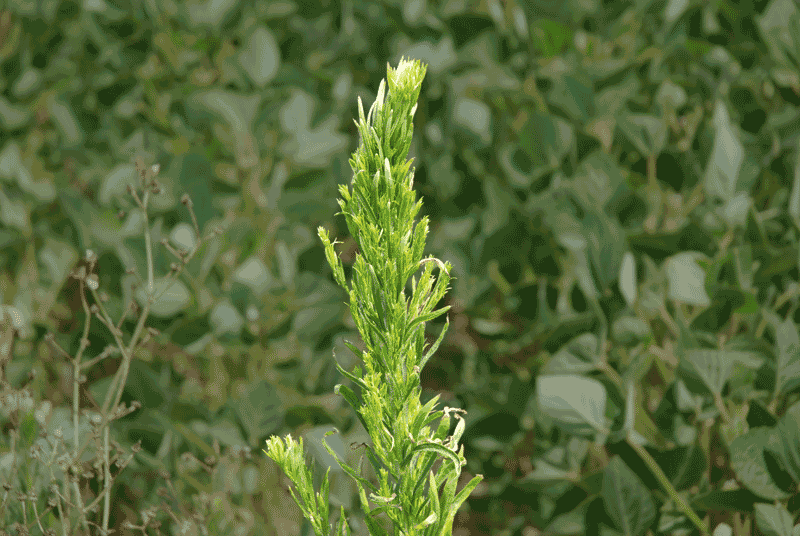Weeding out the problem
THE CROP SCIENCE INDUSTRY AND GLYPHOSATE RESISTANCE
across canada, herbicide resistant weeds are impacting farmers’ bottom lines. A recent poll conducted by Ipsos Reid on behalf of BASF Canada Inc. showed that three out of four growers are seeing yield losses as a result of weeds like Canada fleabane and giant ragweed that are not being killed off by traditional uses of glyphosate.
Over the past two years, glyphosate resistant Canada fleabane has spread across much of southern Ontario. The weed has been found in more than 80 fields through Essex, Kent, and Lambton counties. There has even been a discovery in the Niagara Region. Researchers at the University of Guelph have also seen an increase in the number of sites with glyphosate resistant ragweed, and they’ve seen it over a larger geographic area as well. According to Dr. Peter Sikkema at the University’s Ridgetown Campus, they’ve found it as far east as Napanee.
PHOTO: CANADA FLEABANE

BASF canada inc.
BASF researchers have been studying three of their weed control products on their test field north of London – Eragon®, Integrity®, and Optill™. Integrity, already used on corn fields, has now been registered for use with glyphosate resistant soybeans. Eragon is registered for use in soybeans, wheat, barley and corn. It’s recommended that Eragon is always tank-mixed with glyphosate for broad-spectrum weed control. According to BASF, it complements the action of glyphosate by mobilizing its active ingredient (Kixor®) throughout the weeds. Registration of Optill for use on soybeans is anticipated next year. When tank-mixed with glyphosate, BASF claims Optill provides a fast and complete burndown of broadleaf weeds and grasses as well as early season residual control.
“Weed control has been good this year despite the lack of moisture,” says Rob Miller, a Field Biologist with BASF. “Sometimes we didn’t get that half an inch of rain that’s needed within the 14 days of application, but once we did get some moisture it activated the product and provided value.”
Miller also says, from a research perspective, it’s good to have dry years or dry sites that show different results. “It’s good to have seen it because we can learn from it. Weeds don’t get the same herbicide coverage in dry years. The leaves fold up and the stem hardens which prevents the chemical from penetrating.”
bayer cropscience
Bayer CropScience is into its second year of sales of Vios™ GS. This herbicide is a one-pass, full season product for Roundup Ready and LibertyLink® corn hybrids. It must be tank mixed with glyphosate or Liberty® in order to put three different modes of action to work, including two new actives (thiencarbazone-methyl, Group 2 and tembotrione, Group 27). Bayer reports seeing good results with this product. However, because it is moisture activated, some fields needed to be re-treated this year due to the dry weather.
Speaking during a Bayer CropScience tour at their Rockwood research farm, Dr. Sikkema stated his belief that we can control Canada fleabane, but you need to have perfect control before the plants emerge. “We have to encourage more than one herbicide mode of action, on every acre, every year. We’ve relied too much on glyphosate for our weed control.”
dow agrosciences
That sentiment is echoed by Paul Foran, Horticulture and Eastern Crops Representative for Dow AgroSciences. “Multiple modes of action are needed because otherwise resistant weeds survive and multiply,” he says. “There is a need for new technology to deal with hard to control weeds.”
Dow AgroSciences is awaiting registration of their Enlist™ weed control system. It will provide tolerance to Enlist Duo™ herbicide with Colex-D™ technology, a proprietary blend of glyphosate and new 2,4-D choline. This system is expected to be approved for use in 2013, with the Enlist trait corn seed sold on an introductory basis this fall. Soybean trait approval is anticipated later this year, but the seed won’t be marketed until 2015 when approvals have been granted outside of Canada and the US.
Foran has been testing the product at one of Dow AgroSciences’ confined research sites in Thames Centre, outside London. Corn plots have shown good results with the Enlist Duo herbicide against glyphosate resistant Canada fleabane and giant ragweed.
Drift retardant agents have been included in the formulation of the herbicide. It means less damage to sensitive crops that may be nearby. But Foran says chemistry alone won’t fully prevent drift. That’s why they tested different application methods. They found that a coarse droplet from an air induction nozzle provided the best result — minimizing driftable fines. And when used with a higher water mix, it provided the most effective dispersal of the herbicide.
Dr. Sikkema says studies are being done to determine why giant ragweed is glyphosate resistant and researchers continue to document the spread of the problem. As the crop science industry works to maintain the effective use of glyphosate, they’re encouraging farmers to use multiple products with different modes of action to prevent the development of other herbicide resistant weeds in the future. •






















